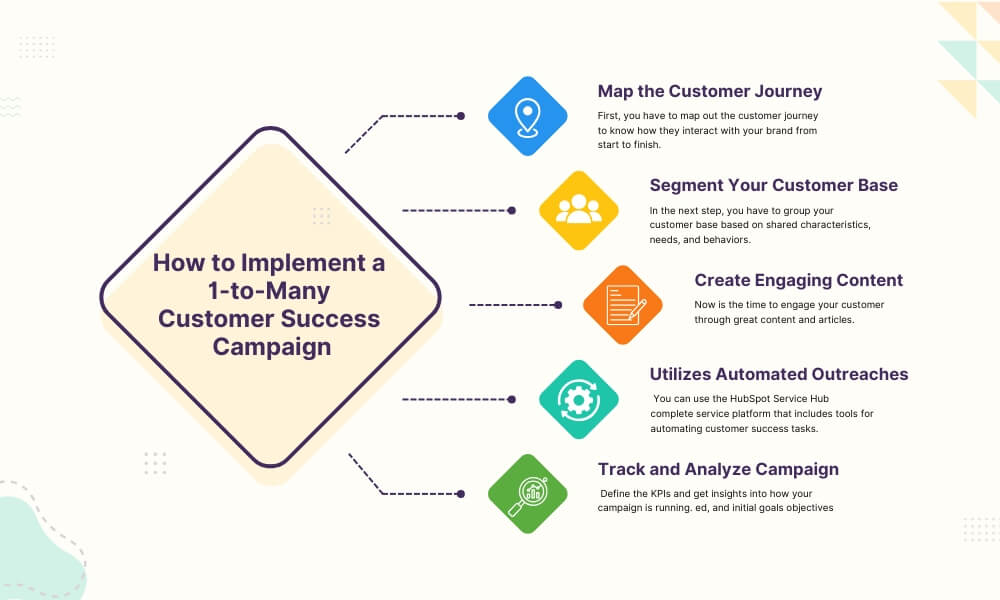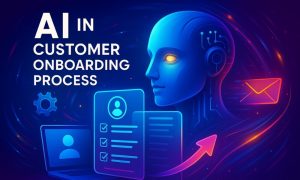1-to-many customer campaigns are scalable strategies businesses use to improve the customer satisfaction level and build long-term relationships. By utilizing automation and efficient processes, businesses can handle large customer volumes smoothly.
For example, a CSM at a SaaS company designs an automated onboarding email series to optimize the customer’s sign-up source, targeting high customer volume. The goal is to ensure personalized approaches to help the customer maximize the value of the product features.
Keep on reading for a successful blueprint of a 1-to-many CS campaign, its benefits, and expert guides.
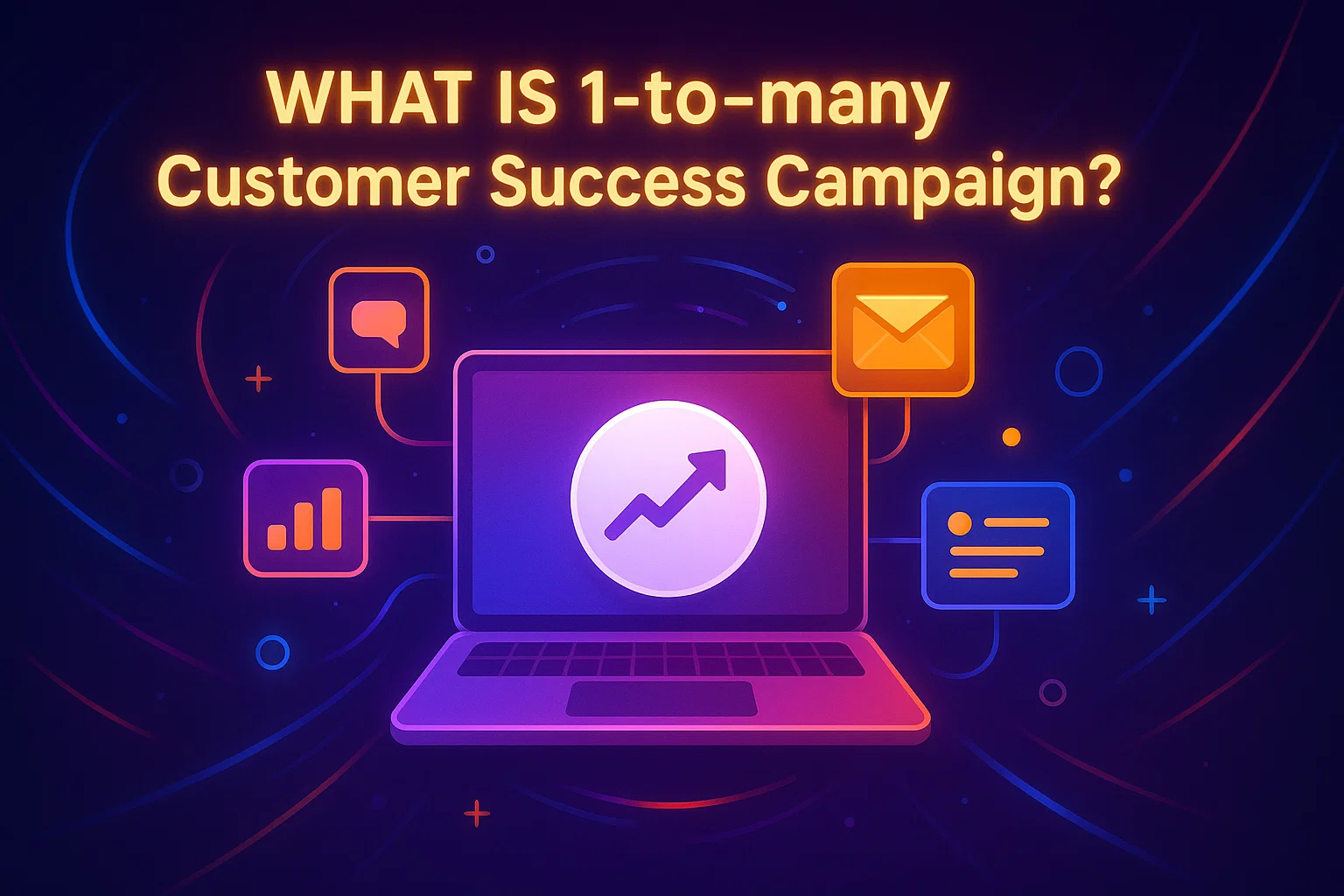
What is 1-to-many Customer Success Campaign?
1-to-many CS campaign is a business strategy where customer success managers use automation and segmentation tools to handle a large volume of customers. They help in achieving their goals and driving the maximum value from a product or service.
The thought goes beyond basic customer support. Rather, it focuses on building a strong relationship and ensuring the customer base can better understand and utilize their product or services.
The CS manager utilizes various tools and technologies to engage a large segment of customers at once. It can be achieved through email marketing, webinars, educational resources, or automated customer journeys.
One fantastic example you can consider here is Aruba, a subsidiary of Hewlett-Packard Enterprise. They implemented a grassroots CS initiative using Totango for onboarding, adoption, and expansion.
Results?
- Onboarding time was reduced by 67%
- Retention increased by 20%
- 30-point NPS improvement
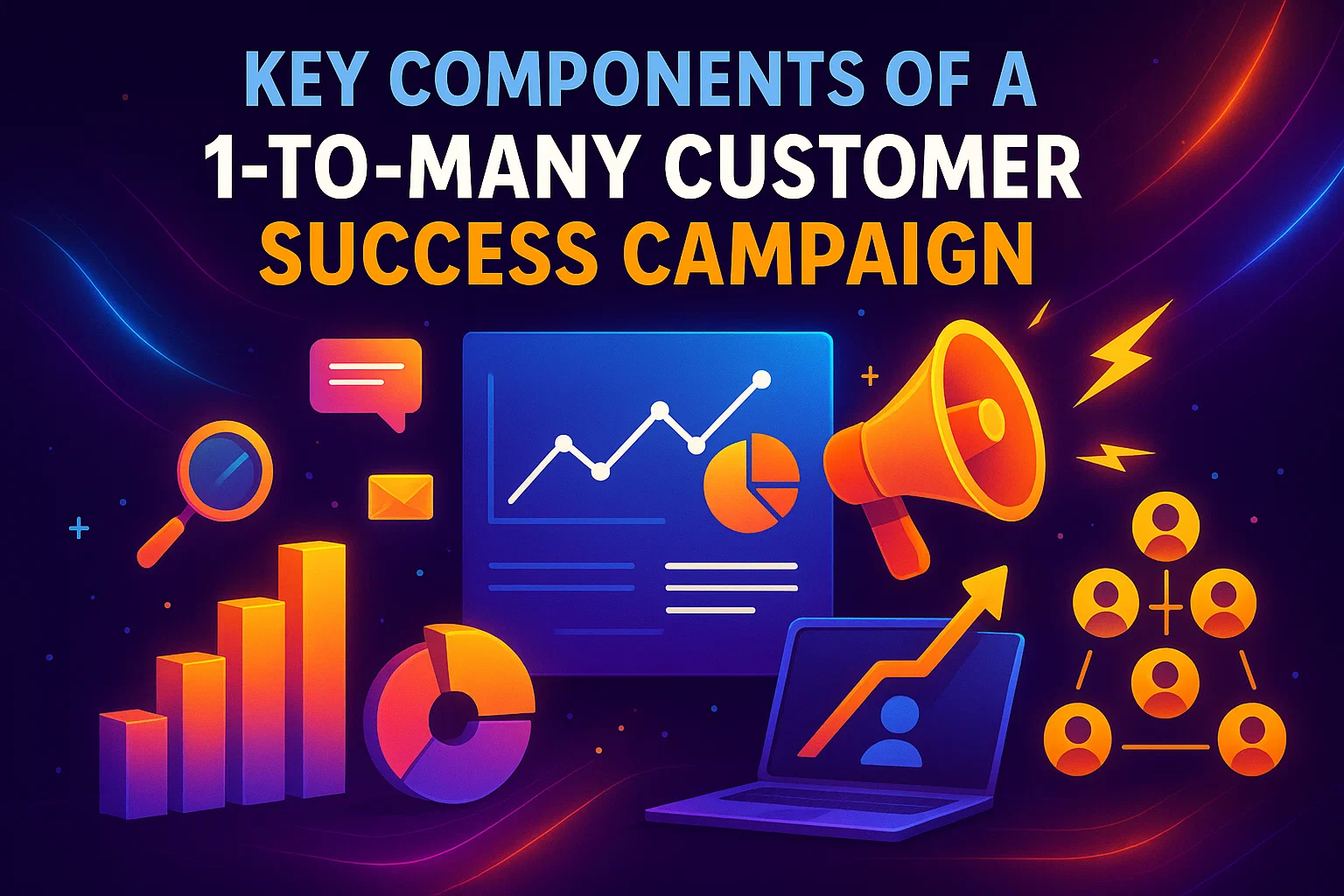
Key Components of a 1-to-Many Customer Success Campaign
Major components of a 1-to-many customer success campaign include customer segmentation, automated workflows, personalized messaging, and other proactive engagement strategies.
Customer Segmentation
Effective customer segmentation ensures that every one of your messages is relevant and meets the customer’s needs. For instance, you can go through the various lifecycle stages, such as onboarding or renewal, or check the user usage patterns from the product or subscription.
Automated Communication Tools
It is the backbone of any 1-to-many campaign. You need to integrate some useful automation tools, such as CRM systems, such as HubSpot or Salesforce, email automation, or marketing automation tools.
Also, you can use communication tools for real-time engagement, automated chat-based support, or a Typeform-type platform for feedback collection based on NPS and other survey results.
Engagement Touchpoints
In any 1-to-many campaign, you must engage customers at multiple touchpoints throughout their journey.
You can utilize:
- Emails: Offer automated email sequences to guide customers through onboarding or product learning phases.
- Webinars: Include scheduled and content-rich webinars to help customers learn new features, best practices, or use cases.
- Communities and Forums: Dedicated customer support platforms where customers can find answers and share experiences.
- NPS & Surveys: Regular feedback channels to measure customer satisfaction and find areas for improvement.
- Gamification: Engage customers by integrating rewards and incentives.
Educational Content and Resources
Content is the heart of the 1-to-many customer success campaigns. According to research, about 81% of consumers found brand content effective in better understanding products or services. It is not about just gathering so much information on one platform. Rather, it should be:
- Relevant: Focus on solving the specific customer problem or adding content, answering their queries technically.
- Educational: Add resourceful blogs or website content to help customers understand the product, its features, and how to use it effectively. 96% of marketers agree that videos are more direct to get into their product or service.
- Proactive: Attend to customer queries and their needs before they even ask. Like through FAQs or feature updates.
Self-Service and Education
Along with educating them, you need to guide customers with self-serve 1-to-many campaigns. A recent Zendesk research reveals that 69% of customers prefer to solve issues on their own rather than through a support agent.
The customer should find the answers to their queries through:
- Knowledge bases: Searchable articles, troubleshooting guides, and how-to content.
- In-app tips: Contextual walkthroughs, tooltips, and usage suggestions.
- Customer communities: Online forums and peer support groups where customers help each other and share best practices.
Success Metrics & KPIs
Not just implementation enough unless you are measuring the performance of your 1-to-many CS campaigns.
For instance, here are some useful metrics you can try on:
- Customer Satisfaction (CSAT) Scores: Measures the customer satisfaction level after a specific interaction.
- Net Promoter Score (NPS): Essential to know about customer loyalty and the likelihood of recommending your product to others.
- Product Usage Data: Gives insight into which features are used most frequently by the customers.
- Churn Rates and Retention Metrics: Monitors the trajectory of the customers who are likely to stay with you and the number who have already left the company.
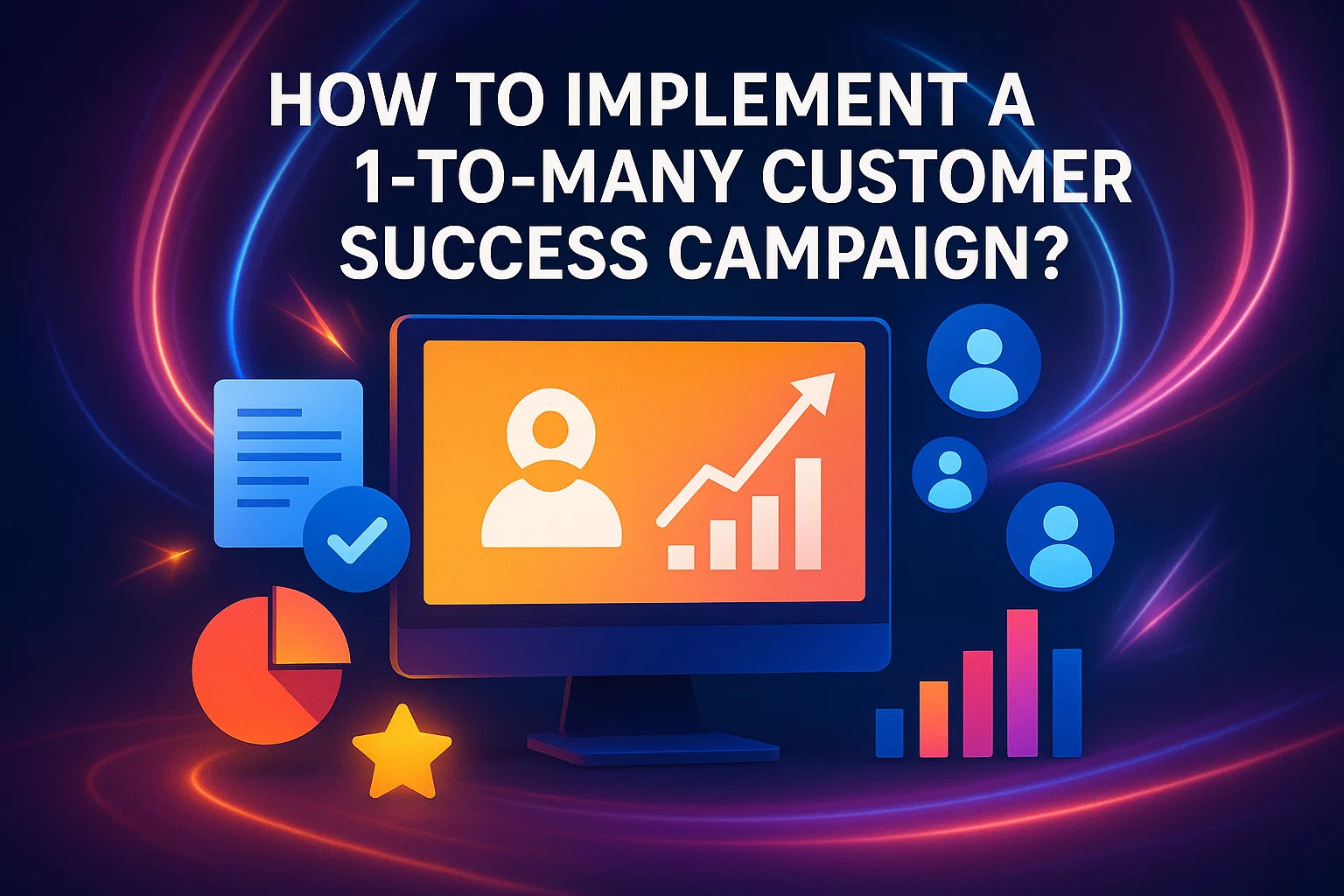
How to Implement a 1-to-Many Customer Success Campaign?
To implement 1-to-many CS campaign, segment customers based on needs, set targeted communication challenges, and deliver a personalized experience. Here are stepwise guidelines:
Map the Customer Journey
First, you have to map out the customer journey to know how they interact with your brand from start to finish. Go through every single stage, including onboarding, awareness, retention, advocacy, and so on. You can use customer lifecycle templates such as HubSpot and Gainsight. Through this, you will find the touchpoints as well where you can engage and educate them.
Segment Your Customer Base
In the next step, you have to group your customer base based on shared characteristics, needs, and behaviors. Pick the right criteria according to your business need, define the customer base, and collect data from each group. Use CRM systems like Salesforce, HubSpot, or Zoho CRM for effective segmentation and data analysis.
Create Engaging Content
Now is the time to engage your customer through great content and articles. It should be effective at engaging customers at different stages of their journey. But before making content, ensure that to have the specific challenges, goals, and expectations of yours. Utilize survey tools like SurveyMonkey and Typeform, and make relevant content.
Select the Right Communication Channels
After establishing content, now head to collaborate with your customer base. As it’s you are targeting large groups, focus on communication through different channels that work better for different segments.
Choose Mailchimp, HubSpot, or ActiveCampaign for email communication, or Intercom or Drift for in-app messaging. Build awareness through social media, paid ads to reach a broader audience, and drive initial interest.
Utilizes Automated Outreaches
Since a 1-to-many campaign reaches a large number of customers, automation is key. You can use the HubSpot Service Hub complete service platform that includes tools for automating customer success tasks. Like ticketing, feedback collection, and communication. Customer.io or Klaviyo are other robust automation tools to manage outreach through email.
Track and Analyze Campaign Performance
Besides implementation, you need to track and analyze the performance of your campaign. Define the KPIs and get insights into how your campaign is running.
You can use HubSpot Analytics or Google Analytics to track real-time analytics and data. Use the data to identify areas for improvement and personalize your approaches.
A/B Testing & Adjust Strategy
A/B testing is a go-to strategy when you want to optimize your 1-to-many customer success campaign and save time. It helps you compare two versions of a campaign element to see which one performs better. For your CS campaign, you can test things like CTAs, email content, and more.
The Differences Between 1-to-1 vs 1-to-Many Campaign
1-to-1 campaigns target individual customer queries with personalized offerings, whereas 1-to-many campaigns focus on larger groups that have almost similar characteristics.
The 1-to-1 and 1-to-many campaign differs in many other aspects. Have a look:
- 1:1 CS campaigns provide more personalized messages and offerings to the specific needs and characteristics of each customer. But 1: Many campaigns utilize standardized messaging and content that can help across a broader audience.
- Communication in the 1-to-1 Campaigns tends to be slower as the CS manager needs to customize interactions individually, which requires more time. On the contrary, 1-to-many Campaigns are faster than that due to automating the process.
- Metrics in 1-to-1 campaigns are often more qualitative. It focuses on customer satisfaction and specific challenges. In contrast, 1-to-many campaigns focus on quantitative metrics like click-through rates or webinar attendance.
- A 1:1 campaign requires a significant investment of time and budget to reach out to each user. On the contrary, 1:many customer success campaigns are cost-effective and efficient as they use automation and technology to reach a large number of accounts.
- 1:1 CS Campaign takes more time but gives better and long-lasting results for high-value customers, but 1: Many cs campaigns have shorter sales cycles and are designed for quick returns.
Expert Tips for a Successful 1-to-Many CS Campaign
Follow this expert guidance and make your 1-to-many CS campaign up to level than competitors.
- Avoid treating all customers the same. Even if it’s a 1-to-many campaign, proper segmentation is a must.
- Implement a multi-channel approach to ensure that every one of your messages doesn’t go unnoticed.
- Automation is powerful in campaigns, but avoid personalizing your approach. Otherwise, it may seem robotic.
- Track performance consistently and use data to optimize your strategy.
- Educated customers are loyal customers. Ensure all your resources in the campaign help customers succeed with your product.
- Don’t miss any customer queries. Proactively engage with at-risk customers before issues arise.
Final Thoughts
To sum up, 1-to-many customer success campaigns help companies scale engagement and drive value for a large customer base.
Through automation, the customer lifecycle with the company, businesses can ensure that customers receive timely support and education. It ensures improved product adoption and long-term retention.
Author
Shirikant is a proven customer success leader who combines sharp business insight with practical experience to improve retention and drive revenue. As the founder of Statwide, he designs customer-first business strategies that guide companies to turn users into loyal and long-term partners. His approaches are built on real results: stronger relationships, higher customer value, and lasting growth.

